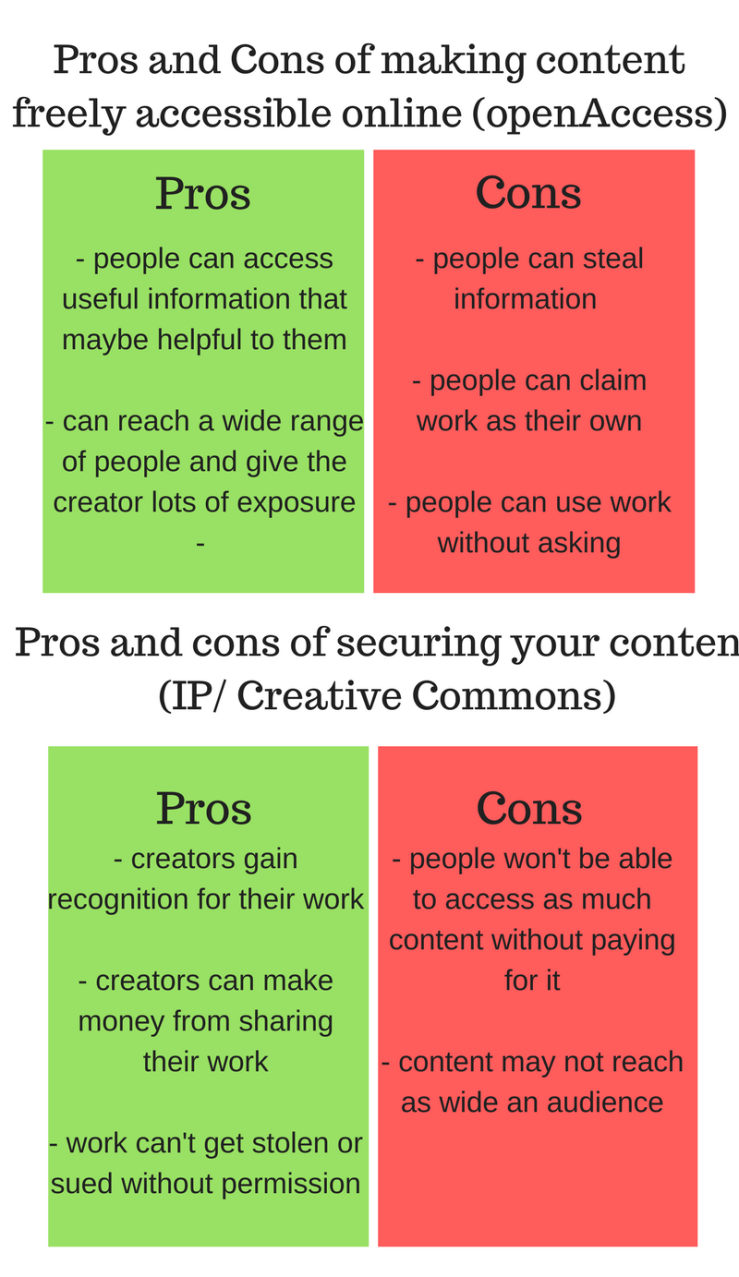The internet is a great way of sharing your work with the world and getting the exposure you desire. However, it does of course have its downsides. Putting your own content online means that millions of people can have access to it meaning they can also use your content without permission, or even worse, claim it as their own work. However there are ways of preventing things like this from happening such as open access, creative commons, and IP. They all help content producers in different ways, some offering more protection to the producers content than others.
What is open access? “Open access is about making the products of research freely accessible to all.”(England) This means that the information is free to read and also that there are very few restrictions on reusing it. This brings many advantages to many users of open access. It is useful to authors, because it means that people will be able to access their work easily and so this means more people will see their work. It is useful to readers because they will have access to more useful information and finally it is useful to funders as they will have funded research and open access will allow it to reach a wider audience.
What is Creative Commons? “Creative Commons is a non profit organisation that works to increase the amount of creativity (cultural, educational, and scientific content) available in “the commons” — the body of work that is available to the public for free and legal sharing, use, repurposing, and remixing.”(“What Is Intellectual Property?”) Many people can use creative commons from individuals to universities and leading technology companies. Creative Commons licenses works by allowing people to easily change their copyright terms from the default of all rights reserved to some rights reserved. This benefits both the producer and researcher because it allows researchers to use the content but still ensures that the producer still owns the content and will gain recognition from it.
What is IP? IP is short for Intellectual property, it “refers to creations of the mind, such as inventions; literary and artistic works; designs; and symbols, names and images used in commerce.”(“What Is Intellectual Property?”) IP is protected in law by, for example, patents, copyright and trademarks, which means that people can earn recognition from what they invent and create and even gain a financial benefit. Intellectual property can be divided into two sections -industrial property and copyright. This type of system works well for both the producers and researchers. It works well for the producers because it rewards them for the content they have worked hard to create and it works well for researchers because it gives the producers the incentive to keep creating useful and enjoyable content.
In conclusion, for a content producer that doesn’t want their work used without reward or recognition, they should choose the route of IP or Creative Commons where their work will be protected. Open access is still a great tool for reaching an even larger audience however it comes with the risk of it being stolen.

References
N.p., 2017. Web. 7 May 2017.
N.p., 2017. Web. 7 May 2017.
England, Higher. “What Is Open Access? – Higher Education Funding Council For England”. Hefce.ac.uk. N.p., 2017. Web. 7 May 2017.
“What Is Intellectual Property?”. Wipo.int. N.p., 2017. Web. 7 May 2017.
“What Is Open Access?”. http://www.springer.com. N.p., 2017. Web. 7 May 2017.
Hi Cherie, I found your blog extremely informative and helpful especially when learning about IP in OA as this is something I hadn’t come across in my research. It’s great to see the advantages this notion has and seems to far out way those of other OA options (green or gold, for example). However, I note your disadvantage that “content may not reach as wide an audience” and wanted to know why you thought this? Because when reading upon this myself I came across this article http://www.wipo.int/tools/en/disclaim.html#open_access in which it is stated that in 2016 the World Intellectual Property Organisation announced a new Open Access Policy, in turn leading to the widest sharing capabilities. Therefore I would question this as a disadvantage. I really look forward to hearing your views.
Harriet.
LikeLike
[…] my comment on Cherie’s post taught me about Intellectual Property (IP) which is something I hadn’t come […]
LikeLike